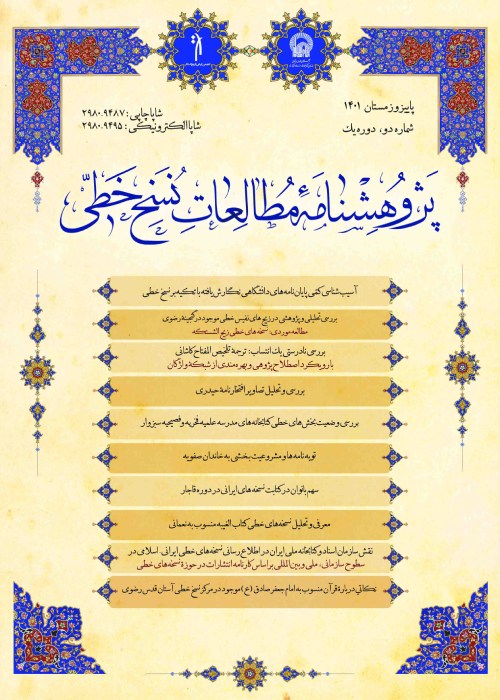Extra-textual Adornments and Ornaments (Covers) in Exquisite Manuscripts of Qajar Period
The present research is intended to examine the features of ornaments and adornments in the manuscripts of the Qajar period in the extra-textual section and to study the types and frequency of various exquisite covers used in the book design of the manuscripts of this period.
Research Method/Approach:
The method of this research is descriptive-analytical, in which the types of exquisite and artistic covers of the Qajar period and their frequency in the National Library repository are enumerated and analyzed by an inductive method, and 84 numbered and dated art manuscripts of the Qajar period have been selected and studied by purposeful sampling.
From among the 84 manuscripts studied, leather covers have the highest frequency with 49 copies, followed by painted and glazed covers with a frequency of 21 copies, and followed by cloth covers with a frequency of 10 copies and one copy of cardboard cover with a dust jacket. Among the oiled covers used in the copies researched, the most frequency is related to the designs of medallion (turanj) and top medallion (sarturanj) and pendentive (lachakī), then to colorful floral and bird motifs, and then to small and large floral motives and arabesque designs. Among the leather covers, the most frequency is related to goat leader (tīmāj) covers with 38 copies. Among the book decorators and bookbinders of the Qajar period, the leather type of covers has been the most frequently used for exquisite copies due to easy access and shorter preparation process. As such, the paint and oil type, due to the difficulty and length of the preparation process, has been used less frequently than the leather covers.By generalizing the findings of this research to other exquisite copies of this period, it can be said that: because the process of preparing oil and paint covers is more complicated than other covers, the artistic oil and paint covers are used in a smaller number than the artistic copies of the Qajar period and in most copies of this period, leather covers are used because of the ease of preparation compared to oil covers.Among the leather covers of this period, tīmāj covers are more frequent than other types of leather covers for two reasons: A. due to the abundance and easy access to tīmāj and B. the ease of implementing the stroke (ḍarbī) designs of turanj, sarturanj, lachakī, and burning in tīmāj as compared to other leathers. Furthermore, the use of artistic fabrics in the making of covers for artistic editions of this period is not very common and in few cases, fabric cover has been used in the covers. This is due to the less strength of the fabric and the possibility of its more wear and tear than leather, paint, and oil.
- حق عضویت دریافتی صرف حمایت از نشریات عضو و نگهداری، تکمیل و توسعه مگیران میشود.
- پرداخت حق اشتراک و دانلود مقالات اجازه بازنشر آن در سایر رسانههای چاپی و دیجیتال را به کاربر نمیدهد.



